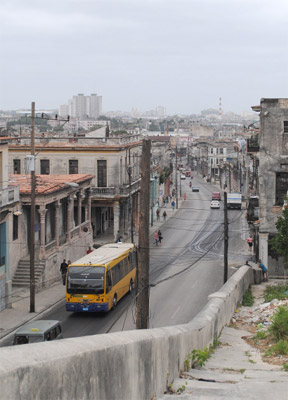On Havana’s Jesus del Monte Avenue
Photo feature by Irina Echarry

HAVANA TIMES — Tucked away in one of the most populated municipalities of the capital, we found a street with history. Known first as the “Camino Real del Sur” (Southern Route) it was the only roadway that led from the city into the countryside.
Later, this bridge of communication between early Havana and the towns of Bejucal and Santiago de las Vegas was named “Calzada de Jesus del Monte” (Jesus del Monte Avunue).
Today it is the famous Diez de Octubre (10th of October) Avenue, the same byway that inspired the 20th century poet Eliseo Diego.
Walking down this street, we come across braced-up houses that have stood the test of time, as well as the busy Toyo Corner, in the oldest parish on the outskirts of Havana, with its Jesus del Monte Chapel (today known as Buen Pastor Chapel), in addition to other buildings.
What few know is that this church was built on land on which the San Francisco de Paula sugar refinery once occupied before being demolished.
People come and go along this “rather large road, which is Jesus del Monte, where too much light forms other walls with the dust.”* This was the magic that amazed Eliseo, but which is now disappearing.
Today the light lets you see a street that has become old, with its rundown buildings and grime; as well as the cars leaving behind smoke that darkens the environment. Though it remains iconic, few poets will ever reminisce about it.
—–
* A verse by Eliseo Diego taken from “El primer discurso.”
Click on the thumbnails below to view all the photos in this gallery. On your PC or laptop, you can use the directional arrows on the keyboard to move within the gallery. On cell phones use the keys on the screen.

























It is a shame that individual building sites are in decay.
I believe that the major factor in the evolution of urban areas is The extreme cost of replacing the proper sewerage, water treatment and electricity is the real stopper to redevelopement.
Chuck
Very true. In the ‘States these old damas have been abandoned for the semi-custom mini-manses of the suburbs. The tax system in the US affords the owners of these dilapidated properties an opportunity to continue to depreciate the properties. They can use the losses as write-offs against passive income generated elsewhere so there is little incentive to repair or sell. In Cuba, people must tragically continue to live in these properties, however, legally or illegally because there are no new developments to move into. The Castros, as property owners, equally have no incentive to repair or condemn because no one dares to complain. Either way bad news.
Not that two wrongs make a right, Moses, but haven’t you noticed the same sort of decay up here in the States? Whole sections of Boston, for example, which were composed of beautiful Victorian homes a hundred years ago, have now been reduced to rubble, like the burned-out hulk of Berlin in 1945. Taking the train south from where I live, in Vermont, I pass one post-industrialist city and town after another, which are in the same state of abandonment. And Detroit is something else! Not only the ‘hoods, but even the center, look like Rome after the barbarian tribes swept through. A few months ago the Guardian, U.K. ran a haunting series of fotos wherein the smashed ball-rooms of grand hotels were depicted (with Steinways still in place, next to a fallen and smashed candeabra, and also those wonderful picture palaces of the 1920’s and 30’s, now in utter ruins. This process has been going on for a long time. Even 19th Century novels relate how the town houses of the 18th Century elite in New York City had degenerated into rooming houses…and finally ruins. Still, it is sad to see the wonderful craftsmanship of past epochs being neglected and destroyed by the passage of time.
It is hard not to get very depressed when you stand on the corner of “Esquina de Tijeras” (10 de Octubre y Jesus del Monte) gazing in all directions and begin to imagine how beautiful this corner once was. How many billions of dollars would be required to restore Havana to its former luster? Will socialism ever be able to keep the buildings from falling down?